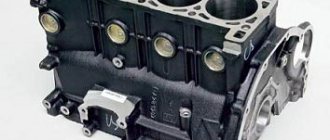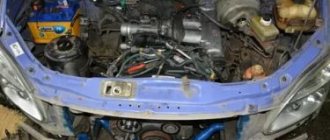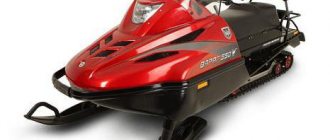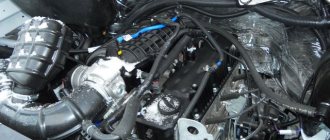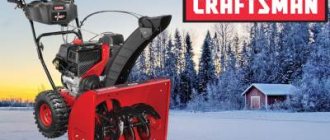The Gorky Automobile Plant has been installing ZMZ-406 engines on Volga and Gazelle cars since 1996. These engines replaced the ZMZ-402, differing from them in greater power and better dynamics with a smaller displacement (2.3 liters versus 2.5 for the 402), moreover, the new engines turned out to be more economical. In the first years of production, GAZ cars were installed carburetor engines, then they were gradually replaced by injection engines.
Engine ZMZ 406 for GAZ cars
On Volga and Gazelle cars the following were used:
- 4061.10 - carburetor on 76 gasoline (compression ratio - 8);
- 4062.10 - injection on 92 gasoline (compression ratio - 9.3);
- 4063.10 - carburetor with 92 gasoline (compression ratio - 9.3).
Some GAZ vehicles also used other engines from the Zavolzhsky Motor Plant, for example, ZMZ-405. Since 2006, only injection engines, more modern and with better characteristics, have been installed on Gazelle and Volga cars. The disadvantages inherent in carburetor options are a thing of the past.
Briefly about the engine line
Since the Volga served as the basis for the Gazelle, the first power unit was the ZMZ-402. It was a carburetor 8-valve engine with a capacity of 100 horsepower. Practice has shown that with a maximum load of one and a half tons of thrust, this engine was severely lacking. At the beginning of the 2000s, namely in 2003, ZMZ-406 began to be installed on the second generation of Gazelles. It was a more advanced engine that developed more power and torque with a volume of 2.4 liters. Now the unit has a 16-valve layout. However, the injection type has not changed here. It remained the same, carburetor. Some people install a 406 injector on the Gazelle. The increase in power is, of course, very noticeable. We also note such a unit as ZMZ-405. This is a modernized version of the 406 engine. It has fuel injection from the factory. It was more reasonable to install a ZMZ-405 injector on the Gazelle engine. After all, the power of this unit is 152 horsepower, which is one and a half times more than that of the 402 engine. And the working volume of the cylinders is 2.5 liters. Ulyanovsk UMZ-4216 engines with a volume of 3 liters are also installed on the new Gazelles.
The unit has an injection system. Maximum power is 123 horsepower. By the way, such engines are found on UAZ Patriot SUVs and some Hunter models.
Typical malfunctions of UMZ-4216
Typical malfunctions of the UMZ-4216 engine in comparison with the ZMZ-405 engine are determined by their small number. The main superior advantage when operating UMZ and ZMZ engines on gas is resistance to valve burnout in front of the ZMZ-405. The indicator of resistance to burnout when using gas fuel (propane, methane) is reduced to almost zero on the UMZ-4216, while on the ZMZ-405 engine the probability of burnout is approximately 70%, which creates an atmosphere for the owner of unexpected repair costs and vehicle downtime.
One of the important characteristic malfunctions of the 4216 is the “triple” of the engine, associated with incorrect thermal clearances of the valves, and this can be solved by elementary regulation. In the case of installed hydraulic compensators, the “triple” fault is eliminated by adjusting the position of the plungers, cleaning the hydraulic compensators, replacing them with new ones or switching to rods without them.
The remaining faults are typical - low fuel pressure, wear of spark plugs and high-voltage wires, etc.
Carburetor characteristics
This power system is used to mix air and gasoline, as well as supply it and regulate flow. At the moment, such intake systems are not mass-produced. They have long been supplanted by the injector. A distinctive feature of the carburetor power system is the mechanical method of mixing fuel. This process took place in a separate device. It's called a carburetor (hence the name).
It has two chambers with floats. The latter are connected to the needle and interact with the jets. According to environmental standards, such engines complied with the Euro-2 standard. This is one of the reasons why such systems have not been installed on cars since 2009.
Hidden malfunction of the ZMZ engine when replacing camshafts and methods of elimination
When replacing camshafts, you should pay special attention to the manufacturer, since purchasing counterfeit ones and installing them on the engine is very likely to result in unbalanced engine operation, popping, jerking and lack of traction. This is a hidden malfunction caused by replacing camshafts that do not meet technical standards. It is called hidden because the car owner has a question about uneven engine operation after repairs and the replacement of completely new spare parts.
A search begins for the reasons that led to the unbalanced operation of the engine and, as a rule, goes through everything from replacing spark plugs to measuring compression in the cylinders. But with all the search actions, specialists receive satisfactory results for each unit they check, and the engine continues to “shake”. Ultimately, if the logic works, then when the old, “original” shafts are returned to their place, the engine operation returns to normal.
In order to prevent such a malfunction caused by installing inappropriate camshafts, it is necessary to carefully inspect it for the treatment of working surfaces and applied markings. To do this, you need to know that the following shafts are produced for engines of the ZMZ family:
— 406.1006015-10 (installed on ZMZ-4062, ZMZ-40522 and ZMZ-409);
— 406.1006015 (installed on ZMZ-4061, ZMZ-4063).
406.1006015 differs from 406.1006015-10 in the lifting height of the pusher - 8 and 9 mm, respectively, and the presence of a less wide phase.
Pay attention to the marking points:
— in the casting, the product number “406” is indicated on the intermediate shaft journal
— on the front end of the shaft the trademark “ZMZ” and stamps of the Quality Control Department controller are applied
— in the casting on the intermediate shaft journal the number of the model kit and the serial number of the casting kit are indicated
- as a distinctive mark for the “4061” engine, a hole with a diameter of 10 mm is drilled to a depth of 2 mm on the surface of the square
- in the casting, the sign “P” is indicated on the intermediate journal of the shaft - the designation of the manufacturer of the workpiece “Ruslich”
It makes no sense to present the results of the study of counterfeit parts in figures in the article, since it is impossible to carry out practically high-precision measurements of complex profiled surfaces in the conditions of even the most expensive car services due to the lack of necessary instruments.
Pros of a carburetor
The first advantage is the low cost of maintenance. Almost every motorist is familiar with the design of this system. The carburetor can be disassembled and reassembled in less than an hour. In addition, such power systems are suitable for 76 gasoline. Their fuel quality requirements are minimal. And if the carburetor becomes clogged, you can disassemble it at any time and clean the jets. As for spare parts, you can find them even now, despite the fact that such internal combustion engines have not been officially produced for almost 10 years. The price of components is very reasonable.
Power units installed on Gazelle
When installing a new engine, many car owners doubt which engine is best for the Gazelle. Experienced mechanics advise first deciding what the Gazelle owner is going to do with his car. Based on the decision made, buy a diesel or gasoline engine.
For example, if a car owner wants to save money on a purchase, then experienced mechanics advise taking the ZMZ 402. What are the positive aspects of this engine:
- service centers sell many used motors of this model;
- eats any oil and works without changes for the worse if the quality of the lubricant changes sharply;
- When removing the original engine, the car owner will not need to redo anything.
But there are also negative aspects to this engine:
- weak dynamics;
- weak power;
- outdated type of engine;
- complex and capricious carburetor design.
Now let's take a closer look at each of the Gazelle engines described below.
Engine ZMZ 402
ZMZ 402 is suitable for Gazelle. It is also installed on the Volga model. Among the listed advantages that were described above, there are such disadvantages as:
- torn rear crankshaft oil seal. It vomits after two thousand revolutions are reached. Oil begins to pour out of the engine. After replacement, everything repeats;
- trembling and jerking of the engine at idle;
- motor overheating. Due to overheating, the washers begin to press in. Therefore, it is recommended to tighten all engine bolts every two thousand kilometers.
Otherwise, the ZMZ 402 engine will fit into the Gazelle like a native one. Nothing will have to be redone. In addition, parts for it can always be found. They are sold at a low price.
Engine ZMZ 405
The engine is generally similar to the 406. Only slightly edited. Added engine power. When installed on a Gazelle, it will give the minibus agility that it did not have with previous engines.
Otherwise there are many shortcomings. For example, such as:
- lubricant leak;
- high gasoline consumption;
- The engine stalls frequently. This happens because problems begin with high-voltage wires;
- noise and knocking due to hydraulic compensators. By the way, the latter are enough for only 50 thousand kilometers.
Similar article Do-it-yourself repair of 402 ZMZ engine
There are two series of engines: injection and carburetor. Injection is little better than carburetor. But experienced mechanics advise buying 405 if the choice is between the ZMZ 405 and ZMZ 406 power units.
Engine ZMZ 406
ZMZ 406 is considered the best among other engines. It is much better than 402, but inferior to 405. The aluminum block is replaced by cast iron. There are now 2 camshafts. These are upper and lower camshafts.
Hydraulic compensators are installed on the engine. Now car owners will not have to constantly reduce valve clearances. The engine has 16 cylinders.
Despite the described advantages, the power unit has the following disadvantages:
- timing wedge;
- timing chain damage;
- motor overheating;
- damage to oil scrapers and seals;
- knocking due to hydraulic compensators;
- problems with electronics.
With proper and constant care, the engine installed in a Gazelle will cover more than 300 thousand kilometers.
Engine ZMZ 409
ZMZ 409 is considered the best engine for installation in a Gazelle. Its cylinder block is cast from gray cast iron. The engine almost never overheats, because between the cylinders there are channels in which coolant flows.
The oil sump is located at the bottom of the BC. The cylinder head is made of aluminum alloy. The intake valves are on the right, and the exhaust valves are on the left. It has almost no disadvantages. Experienced mechanics advise undergoing regular preventive inspections. And then there will be no complaints about the engine.
Disadvantages of the carburetor
Now about the cons. There are many more of them than advantages. So, the first drawback is low stability. This is especially true for winter use. When starting up, the spark plugs often flood. The idle speed must be adjusted manually (there is a “choke” for this). After warming up, the carburetor begins to dose fuel incorrectly. The system requires frequent adjustments. Another disadvantage is the large CO emissions.
On hot days, this system also makes itself felt. And the most significant drawback is power. Even with identical engines it will be at least 20 percent less. Let's take, for example, the 406th and 405th engines produced in Zavolzhsk. The difference between them is 42 horsepower.
Injector
Now let's talk about a more modern intake system. Why do they now install an injector on the Gazelle engine? This system uses electronic fuel injection. It is carried out through nozzles (injectors).
The main function of the system remains the same. The mechanism also prepares and supplies the fuel-air mixture. However, unlike carburetors, this entire process occurs here automatically, using electronics. A special injector unit (microcontroller) reads information from the sensors and transmits this information to the computer. The latter is already sending a signal to the injectors. Note that information is read from a variety of sensors:
- Throttle valve.
- Camshaft positions.
- Lambda probe.
- Idle move.
- Coolant temperatures.
The process of starting the engine is carried out with half a turn. By installing an injector on the Gazelle engine, you will not encounter problems such as flooded spark plugs, floating speeds or excess air leaks. Now all processes are controlled electronically.
Engine Cummins 2.8 "Gazelle"
The Cummins 2.8 engine is installed on GAZ “Gazelle” and GAZ “Next” vehicles, as well as GAZ “Business”. This is a 4-cylinder engine with a power of 88.3 kW and a volume of 2.781 liters. Runs on diesel fuel. The cylinder block is made of gray cast iron with milled cylinder liners. The crankshaft is also made of gray cast iron and is well balanced.
We looked at the main types of engines for Gazelles and their most popular modifications. We hope that this article was useful to you!
Injector advantages
The first plus is stable operation and ignition. The injector operates in automatic mode. You don't have to control the choke or adjust the jets. They are not here. The next plus is low fuel consumption.
This figure is 20 percent less than that of carburetor engine models. And all because the dosage of the mixture occurs with high precision. The electronics reads signals from dozens of sensors (even takes into account the operation of the air conditioner). Another plus is high environmental friendliness. European manufacturers switched to injection engines more than 20 years ago. We also note that it is easier for such an engine to gain speed compared to a carburetor. Hence the difference in power.
Possible malfunctions of ZMZ 406 (405) engines
- The engine does not start or starts with prolonged rotation of the starter. In this case, check the fuel pressure in the injector rail. The pressure in the ramp with a backflow when the ignition is turned on should reach 3 atm, in a ramp that does not have a backflow - 3.8 atm. It is also necessary to ensure that the coolant temperature sensor is working properly.
- The engine suddenly (possibly after a click) began to operate unbalanced and noise appeared in the camshaft drive chain. The problem that has arisen may be associated with jamming of the hydraulic chain tensioner, which leads to sagging and a link jumping on the sprocket.
- Engine oil consumption has increased. Pay attention to the exhaust in the muffler. If there is a lot of smoke coming from the exhaust, the valve stem seals may be damaged. The cause of high flow may also be a lack of tightness between the valve cover and the labyrinth oil slinger.
- The dips that arise during sudden acceleration are caused by ignition coils that have an interturn short circuit.
- If the engine stalls after rain, then you need to check the presence of water in the spark plug wells.
What's better?
So, which engine to choose for the Gazelle - injection or carburetor? Having analyzed the positive and negative aspects of both nodes, we came to the conclusion that the first system is considered more reliable and technologically advanced.
Although diagnosing an injector is a rather complicated process, the car will need it every 5 or even 10 years. Problems with the carburetor occur already in the first week of operation (especially if contact ignition is used).
